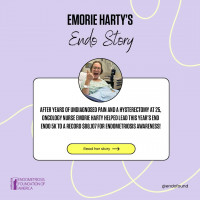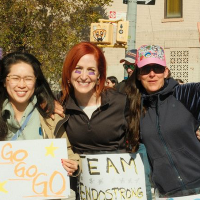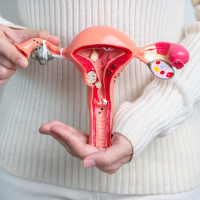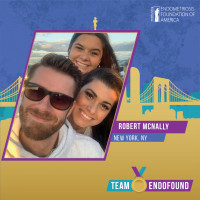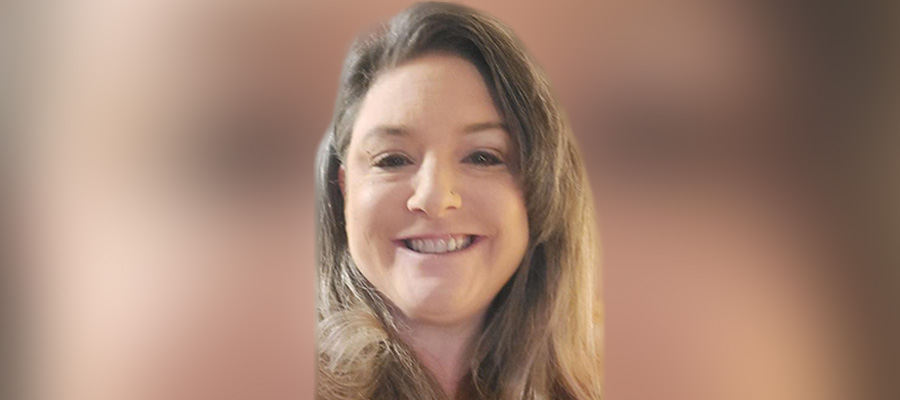
Rachel Seifried’s endometriosis story is most unusual. The disease grew silently until she was in her mid-30s, wreaked havoc on her body for two years, and has not been a problem since a hysterectomy 10 years ago. Today, having told few people outside of her immediate family about it, she’s decided to share it publicly.
“I found the EndoFound website and read all the women’s stories there and everything they went through,” she said. “I realized that I needed to tell mine because it could help someone.”
Seifried, 47, is a college admissions representative from just north of Pittsburgh. She had no symptoms of endometriosis in her teens or 20s, though it was unknowingly growing inside her. Known as silent endometriosis, this form affects 20 to 25 percent of women who have the disease. At the age of 31 in 2009, with Seifried and her husband unable to conceive and with no idea why, they turned to IVF treatments.
“I saw three different IVF doctors over two years, one referring me to the next because nothing was working,” Seifried said.
One of the doctors did a laparoscopy to try to find a cause for Seifried’s infertility. While Seifried said the doctor told her she had some adhesions and a partially blocked fallopian tube, nobody mentioned the word endometriosis to her or seemed too concerned, so the IVF treatments continued.
Two years later, in 2011, Seifried got pregnant but had a miscarriage.
“That’s when my husband and I said we were done trying. It was a very emotional time for us,” she said. “I went off all fertility drugs at that point.”
Aside from the infertility, Seifried continued to live without any symptoms—but that all changed overnight two years later.
“It was April 29, 2013,” she recalled. “I woke up with a throbbing, persistent pain below my tailbone. It wasn’t debilitating, but nothing I took helped. When my husband got home [he’d been out of town], he took me to the emergency room. They did an ultrasound and said my left ovary was being strangled by a cyst. I thought that was odd because I had no pain on my left side, but they said I needed emergency surgery to remove the cyst and maybe my ovary.”
The surgery didn’t happen, however, because Seifried’s insurance company was in the midst of a lengthy dispute with the hospital and wouldn’t cover it.
“My doctor told me not to do the surgery, to go home, and to see her in the morning,” Seifried said. “By the time I got to her office the next day, I couldn’t stand because of the pain. At one point, she pushed on the left side of my lower pelvic area, and I damn near kicked her. She agreed that the left ovary was the problem, but there was still no mention of endometriosis.”
The doctor sent Seifried for surgery at a different hospital, where she had to wait for hours because the previous hospital wouldn’t release her records. When they finally did, and Seifried was admitted, she was in the worst pain of her life.
“I begged the surgeon to knock me out,” she said. “I couldn’t take it anymore.”
The surgery revealed Seifried had stage IV endometriosis. She didn’t know what endometriosis was or what stage IV meant, but she had some idea after the doctor described to her what he found.
“He said I had no free-flowing organs in my pelvic area,” Seifried said. “My bladder, uterus, ovaries, rectum—when he’d touch one of them, they’d all move because they were stuck together by the endo. He ended up taking out my left ovary and right fallopian tube. He also found I had a tumor the size of a golf ball that stuck my uterus to my rectum.”
The doctor, not confident in his ability to remove the tumor or all of the endometriosis because of its expansiveness, referred Seifried to another surgeon, who put her on Lupron for six months to see if that would reduce the size of the tumor.
“It was probably the worst six months of my life,” Seifried said. “I had hot flashes, night sweats, and mood swings. I was running between work and doctor appointments in pain, trying to function as a human. I wasn’t able to get pregnant. It was all so miserable and depressing. I had no endometriosis symptoms until I had all of them.”
At the end of 2013, with the Lupron not helping, the surgeon successfully removed the tumor and excised massive amounts of endometriosis. Seifried remained well until 2015, when the pain returned. She said scans revealed an endometrial tumor in her uterus, which brought up the possibility of it being cancerous and led to another surgery. Seifried had a full hysterectomy and more endometriosis removed from other organs. While a hysterectomy does not necessarily end a patient’s symptoms, the entire surgery performed on Seifried did. She had some minor discomfort in 2020, but tests showed it was an insignificant issue that had nothing to do with endometriosis.
“That was the end of everything,” Seifried said. “I’ve had no issues at all since then. No pain. No discomfort.”
Seifried said her story is important because, with endometriosis, one never knows what can happen at any time.
“There I was in my 30s trying to get pregnant and had no clue why I couldn’t,” she said. “It’s important not just to know what it is. You have to know the right questions to ask, and then you have to ask them.”
Seifried also hopes her story will help patients manage the psychological aspect of the disease and that families, friends, and doctors will support them at every turn.
“I went through so much mentally,” she said. “It took me a long time to process that I couldn’t have kids and to really start talking about what I went through. I think I just didn’t want anybody to feel bad for me, so I didn’t tell them how I felt. I didn’t want to explain my pain or that I couldn’t have children. I felt like I let my husband down—and my mom down because I couldn’t give her grandchildren. But I’ve learned that endo and its effects are nothing to be ashamed of. And my husband, mom, and doctors were my biggest supporters. I don’t know how I would have gotten through this without them.”
*Patient stories submitted to EndoFound.org are the patient's views, not necessarily those of the foundation. All testimonials are from real patients, may not reflect the typical patient’s experience, and are not intended to represent or guarantee that anyone will achieve the same or similar results.





